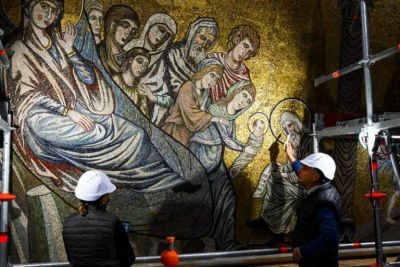Restorers launched a groundbreaking project in Florence's historic Baptistry last month, allowing visitors a unique view of magnificent mosaics including a three-headed devil which inspired Italian poet Dante. For the next six years, tourists will be able to climb a specially-engineered, mushroom-shaped scaffold to examine up close over 3,000 square feet of richly-colored and gold biblical depictions in the dome. The cycle of medieval mosaics, made with an estimated 10 million tesserae measuring between five to 20 millimeters each, were designed by three generations of artists, including Cimabue, believed to be the painter Giotto’s teacher. “It will be the first – and I hope last – time that the public will be able to see these mosaics up close, because it will mean this restoration was a success,” architect and project manager Samuele Caciagli told AFP. The ceiling of the octagonal Baptistery, which sits opposite the Duomo in Florence’s historic center and which has hosted baptisms including that of Dante Alighieri in 1266, was last restored over a century ago. But now “there are cracks in every segment (of the dome) and a series of depressions… as well as detachments from the surface,” Beatrice Agostini, who oversees the restoration team, told AFP. Since 2014, Florence’s Opera di Santa Maria del Fiore organization has been carrying out a 10-million-euro restoration of the whole building, with the white and green marble interior walls finished last year. Scaffolding for the ceiling work had to be designed in such a way as to keep doors open to the over one million people who visit the Tuscan city’s oldest religious monument every year. Visitors to the platform, which sits almost 100 feet up, will climb to stand face-to-face with Christ, cherubs, virgins, monks and monsters.
Il prossimo mese, un progetto innovativo per restaurare un magnifico mosaico include un diavolo a tre teste che è stato fonte d'ispirazione per il poeta Dante. Per i prossimi sei anni, i turisti hanno l'opportunità di salire su un'impalcatura a forma di fungo per vedere più di 278 metri quadrati di opere d'arte raffiguranti storie bibliche. I mosaici medievali sono realizzati con oltre 10 milioni di tessuti da 5 a 20 millimetri, disegnati da tre generazioni di artisti, tra cui Cimabue, che fu professore di Giotto. Secondo l'architetto e project manager Samuele Caciagli, questa sarà la prima volta che il pubblico potrà vedere questi mosaici e significa che il restauro è un successo. Il soffitto del Battistero ottagonale, che si trova di fronte al Duomo (nel centro storico di Firenze) è stato restaurato più di un secolo fa. Caciagli ha spiegato che ci sono crepe in ogni segmento della Cupola e una serie di distacchi in superficie, tra cui l'Opera di Santa Maria del Fiore. Il restauro del Battistero terminato lo scorso anno, edificio costituito da muri di marmo bianco e verde che è costato 10 milioni di euro per l'intero edificio. Il ponteggio è stato progettato in modo da tenere aperte le porte durante il restauro ai 10 milioni di turisti che ogni anno visitano la città e il monumento religioso. Il monumento è alto più di 30 metri e i visitatori possono trovarsi faccia a faccia con il dipinto di Cristo, cherubini, vergini, monaci e mostri.



